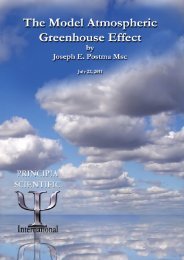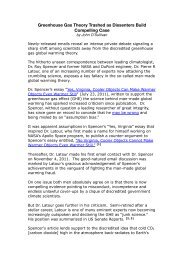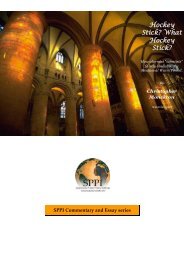Than 1000 International Scientists Dissent Over Man-Made Global ...
Than 1000 International Scientists Dissent Over Man-Made Global ...
Than 1000 International Scientists Dissent Over Man-Made Global ...
Create successful ePaper yourself
Turn your PDF publications into a flip-book with our unique Google optimized e-Paper software.
themselves behind more and more pseudo explanations, which are not part of the academic<br />
education or even of the physics training." (LINK) & (LINK)<br />
Geologist/Geochemist Dr. Tom V. Segalstad, a professor and head of the Geological<br />
Museum at the University of Oslo and formerly an expert reviewer with the UN<br />
IPCC, expressed skepticism of climate fears in 2007. A July 7, 2007 article in Canada's<br />
Financial Post read, "In the real world, as measurable by science, CO2 in the atmosphere<br />
and in the ocean reach a stable balance when the oceans contain 50 times as much CO2 as<br />
the atmosphere. ‗The IPCC postulates an atmospheric doubling of CO2, meaning that the<br />
oceans would need to receive 50 times more CO2 to obtain chemical equilibrium,' explains<br />
Prof. Segalstad. ‗This total of 51 times the present amount of carbon in atmospheric CO2<br />
exceeds the known reserves of fossil carbon-- it represents more carbon than exists in all<br />
the coal, gas, and oil that we can exploit anywhere in the world.'" The article continued,<br />
"Also in the real world, Prof. Segalstad's isotope mass balance calculations -- a standard<br />
technique in science -- show that if CO2 in the atmosphere had a lifetime of 50 to 200<br />
years, as claimed by IPCC scientists, the atmosphere would necessarily have half of its<br />
current CO2 mass. Because this is a nonsensical outcome, the IPCC model postulates that<br />
half of the CO2 must be hiding somewhere, in ‗a missing sink.' <strong>Man</strong>y studies have sought<br />
this missing sink -- a Holy Grail of climate science research-- without success. ‗It is a<br />
search for a mythical CO2 sink to explain an immeasurable CO2 lifetime to fit a<br />
hypothetical CO2 computer model that purports to show that an impossible amount of<br />
fossil fuel burning is heating the atmosphere,' Prof. Segalstad concludes. ‗It is all a<br />
fiction.'" (LINK)<br />
Geologist Dr. David Kear, the former director of geological survey at the Department<br />
of Science and Industrial Research in New Zealand, called predictions of rising sea level<br />
as a result of man-made global warming "science fiction," and said the basic rules of<br />
science are being ignored. "When youngsters are encouraged to take part in a school<br />
science fair the first thing they are told to do is check the results, then re-check them,<br />
something NIWA [National Institute of Water and Atmospheric Research] appear to have<br />
forgotten to do," Kear said in a April 13, 2007 article. "In looking at the next 50 years, why<br />
have they not studied the past 50 years and applied their findings to the predictions? One<br />
would think this was a must," Kear explained. The article continued, "First global warming<br />
predictions made in 1987 estimated an annual rise in sea levels of 35mm. That scared the<br />
world but since then, the figure has continued to be reduced by ‗experts.'" Kear concluded,<br />
"Personal beliefs on climate change and rising sea levels should be delayed until just one of<br />
the many predictions made since 1985 on the basis of carbon additions to the atmosphere<br />
comes true." (LINK)<br />
Solar Physicist and Climatologist Douglas V. Hoyt, who coauthored the book The Role<br />
of the Sun in Climate Change and has worked at both the National Oceanic and<br />
Atmospheric Administration (NOAA) and the National Center for Atmospheric<br />
Research (NCAR), has developed a scorecard to evaluate how accurate climate models<br />
have been. Hoyt wrote, "Starting in 1997, we created a scorecard to see how climate model<br />
predictions were matching observations. The picture is not pretty with most of the<br />
predictions being wrong in magnitude and often in sign." (LINK) A March 1, 2007 blog<br />
post in the National Review explained how the scoring system works. "[Hoyt] gives each<br />
prediction a ‗yes-no-undetermined score.' So if the major models' prediction is confirmed,<br />
179





